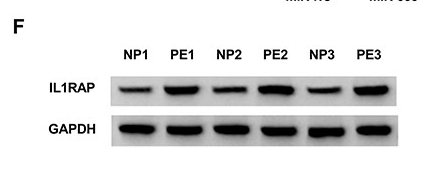IL1RAP Antibody - #DF13533
| 製品: | IL1RAP Antibody |
| カタログ: | DF13533 |
| タンパク質の説明: | Rabbit polyclonal antibody to IL1RAP |
| アプリケーション: | WB |
| Cited expt.: | WB |
| 反応性: | Human, Mouse, Rat |
| 予測: | Horse, Sheep, Rabbit, Dog, Chicken |
| 分子量: | 65kDa; 65kD(Calculated). |
| ユニプロット: | Q9NPH3 |
| RRID: | AB_2846552 |
製品説明
*The optimal dilutions should be determined by the end user. For optimal experimental results, antibody reuse is not recommended.
*Tips:
WB: For western blot detection of denatured protein samples. IHC: For immunohistochemical detection of paraffin sections (IHC-p) or frozen sections (IHC-f) of tissue samples. IF/ICC: For immunofluorescence detection of cell samples. ELISA(peptide): For ELISA detection of antigenic peptide.
引用形式: Affinity Biosciences Cat# DF13533, RRID:AB_2846552.
折りたたみ/展開
C3orf13; FLJ37788; IL 1 receptor accessory protein; IL 1R 3; IL 1R3; IL 1RAcP; IL 1RAP; IL-1 receptor accessory protein; IL-1R-3; IL-1R3; IL-1RAcP; IL-1RAP; IL1 receptor accessory protein; IL1AP_HUMAN; IL1R3; IL1RAcP; Il1rap; Interleukin 1 Accessory Protein; interleukin 1 receptor 3; Interleukin 1 receptor accessory protein; interleukin 1 receptor accessory protein beta; Interleukin-1 receptor 3; Interleukin-1 receptor accessory protein;
免疫原
A synthesized peptide derived from human IL1RAP, corresponding to a region within C-terminal amino acids.
Detected in liver, skin, placenta, thymus and lung. Isoform 4 is predominantly expressed in brain. Overexpressed on candidate chronic myeloid leukemia (CML) stem cells, hematopoietic stem cells and mononuclear cells of patients with acute myeloid leukemia (AML). Overexpressed in patients with chronic obstructive pulmonary disease (COPD). Expressed in T-helper 1 (Th1) and T-helper 2 (Th2) cell subsets (PubMed:10653850).
- Q9NPH3 IL1AP_HUMAN:
- Protein BLAST With
- NCBI/
- ExPASy/
- Uniprot
MTLLWCVVSLYFYGILQSDASERCDDWGLDTMRQIQVFEDEPARIKCPLFEHFLKFNYSTAHSAGLTLIWYWTRQDRDLEEPINFRLPENRISKEKDVLWFRPTLLNDTGNYTCMLRNTTYCSKVAFPLEVVQKDSCFNSPMKLPVHKLYIEYGIQRITCPNVDGYFPSSVKPTITWYMGCYKIQNFNNVIPEGMNLSFLIALISNNGNYTCVVTYPENGRTFHLTRTLTVKVVGSPKNAVPPVIHSPNDHVVYEKEPGEELLIPCTVYFSFLMDSRNEVWWTIDGKKPDDITIDVTINESISHSRTEDETRTQILSIKKVTSEDLKRSYVCHARSAKGEVAKAAKVKQKVPAPRYTVELACGFGATVLLVVILIVVYHVYWLEMVLFYRAHFGTDETILDGKEYDIYVSYARNAEEEEFVLLTLRGVLENEFGYKLCIFDRDSLPGGIVTDETLSFIQKSRRLLVVLSPNYVLQGTQALLELKAGLENMASRGNINVILVQYKAVKETKVKELKRAKTVLTVIKWKGEKSKYPQGRFWKQLQVAMPVKKSPRRSSSDEQGLSYSSLKNV
種類予測
Score>80(red) has high confidence and is suggested to be used for WB detection. *The prediction model is mainly based on the alignment of immunogen sequences, the results are for reference only, not as the basis of quality assurance.
High(score>80) Medium(80>score>50) Low(score<50) No confidence
研究背景
Coreceptor for IL1RL2 in the IL-36 signaling system (By similarity). Coreceptor with IL1R1 in the IL-1 signaling system. Associates with IL1R1 bound to IL1B to form the high affinity interleukin-1 receptor complex which mediates interleukin-1-dependent activation of NF-kappa-B and other pathways. Signaling involves the recruitment of adapter molecules such as TOLLIP, MYD88, and IRAK1 or IRAK2 via the respective TIR domains of the receptor/coreceptor subunits. Recruits TOLLIP to the signaling complex. Does not bind to interleukin-1 alone; binding of IL1RN to IL1R1, prevents its association with IL1R1 to form a signaling complex. The cellular response is modulated through a non-signaling association with the membrane IL1R2 decoy receptor. Coreceptor for IL1RL1 in the IL-33 signaling system. Can bidirectionally induce pre- and postsynaptic differentiation of neurons by trans-synaptically binding to PTPRD (By similarity). May play a role in IL1B-mediated costimulation of IFNG production from T-helper 1 (Th1) cells (Probable).
Associates with secreted ligand-bound IL1R2 and increases the affinity of secreted IL1R2 for IL1B; this complex formation may be the dominant mechanism for neutralization of IL1B by secreted/soluble receptors. Enhances the ability of secreted IL1R1 to inhibit IL-33 signaling (By similarity).
Unable to mediate canonical IL-1 signaling. Required for Src phosphorylation by IL1B. May be involved in IL1B-potentiated NMDA-induced calcium influx in neurons (By similarity).
Cell membrane>Single-pass type I membrane protein.
Secreted.
Secreted.
Detected in liver, skin, placenta, thymus and lung. Isoform 4 is predominantly expressed in brain. Overexpressed on candidate chronic myeloid leukemia (CML) stem cells, hematopoietic stem cells and mononuclear cells of patients with acute myeloid leukemia (AML). Overexpressed in patients with chronic obstructive pulmonary disease (COPD). Expressed in T-helper 1 (Th1) and T-helper 2 (Th2) cell subsets.
The TIR domain mediates NAD(+) hydrolase (NADase) activity. Self-association of TIR domains is required for NADase activity.
Belongs to the interleukin-1 receptor family.
研究領域
· Environmental Information Processing > Signal transduction > MAPK signaling pathway. (View pathway)
· Environmental Information Processing > Signaling molecules and interaction > Cytokine-cytokine receptor interaction. (View pathway)
· Organismal Systems > Immune system > Th17 cell differentiation. (View pathway)
· Organismal Systems > Sensory system > Inflammatory mediator regulation of TRP channels. (View pathway)
参考文献
Application: WB Species: Human Sample: placental tissues
Restrictive clause
Affinity Biosciences tests all products strictly. Citations are provided as a resource for additional applications that have not been validated by Affinity Biosciences. Please choose the appropriate format for each application and consult Materials and Methods sections for additional details about the use of any product in these publications.
For Research Use Only.
Not for use in diagnostic or therapeutic procedures. Not for resale. Not for distribution without written consent. Affinity Biosciences will not be held responsible for patent infringement or other violations that may occur with the use of our products. Affinity Biosciences, Affinity Biosciences Logo and all other trademarks are the property of Affinity Biosciences LTD.

